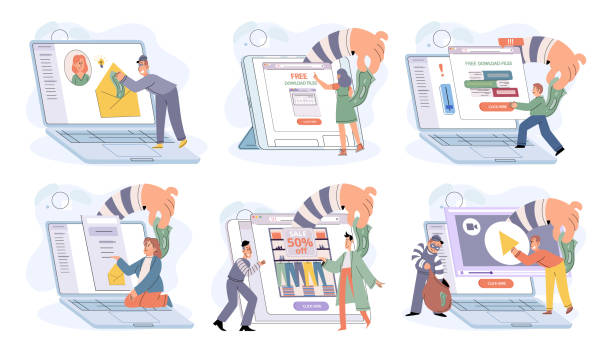Introduction to User-Friendly Website Design and Its Importance

User-friendly website design is no longer a luxury choice, but an absolute necessity for any business seeking success in today’s digital world.
The concept of
User Experience (UX) is at the heart of this type of design, and its goal is to ensure that your website visitors can easily, effectively, and enjoyably interact with your content and services.
This not only leads to increased customer satisfaction but also directly impacts key performance indicators of your website such as conversion rate, time on site, and bounce rate.
A #user_friendly_website helps visitors achieve their goal without confusion, whether it’s purchasing a product, finding information, or making contact.
Investing in strong #UX_design is, in fact, an investment in the future of your business.
To achieve a truly efficient and pleasant website, all aspects from the user’s entry to their exit must be considered.
This includes loading speed, visual layout, navigation simplicity, and content quality.
In this educational article, we will delve into the key elements and principles of
user-friendly website design and provide practical guidelines for improving your website.
Understanding how your users think and what their needs are is the first step in creating an exceptional online experience.
This analytical approach helps you identify potential problems before they occur and find effective solutions for them.
Are you tired of your company’s website not meeting your expectations? With Rasav, design a professional website that truly represents your business.
✅ Increase the acquisition of new customers and sales leads
✅ Boost your brand’s credibility and trust among your audience
⚡ Get a free website design consultation!
Fundamental Principles of User-Friendly Website Structure

Building a user-friendly website goes beyond visual aesthetics; it means creating a seamless and effective experience for visitors.
The first principle is Responsive Design.
Your website must display and function correctly on every device, from desktop to mobile and tablet.
This principle helps user-friendly website design ensure maximum accessibility.
The second principle is website loading speed.
Studies have shown that users expect a web page to load in less than three seconds, otherwise, many of them will leave the website.
Optimizing images, using caching, and compressing code can significantly increase your site’s speed.
High speed not only improves user experience but is also crucial for SEO.
Visual and simple navigation is the third fundamental pillar.
Users should be able to easily navigate your website and find what they are looking for.
This includes clear menus, appropriate internal links, and a logical hierarchical structure for pages.
Poor navigation can confuse users and cause them to quickly exit the site. Use familiar icons and standard phrases for links and buttons.
Finally, a clear and compelling Call to Action (CTA) is of paramount importance.
Users need to know what the next step is and how they can take it.
CTA buttons and links should be prominent and easily recognizable.
All these principles combine to transform a website design into an optimal user experience.
User Understanding and Initial Design Research

User-friendly website design is not possible without a deep understanding of the users who will interact with it.
This specialized stage is the cornerstone of any successful design.
User Research helps you understand the needs, desires, behaviors, and pain points of your target users.
There are various methods for conducting this research, including interviews, surveys, focus groups, and observing user behavior.
One of the powerful tools at this stage is the creation of User Personas.
Personas are fictional, semi-realistic characters that reflect the characteristics of your target users based on research data.
For each persona, you can define information such as age, occupation, interests, goals, and challenges.
This helps the design team build more empathy with users and make design decisions based on their actual needs.
Furthermore, mapping the User Journey, which illustrates the various stages a user goes through to achieve a specific goal on the website, is very effective in identifying potential strengths and weaknesses in the user experience.
These analyses provide the foundation for a targeted and user-centered website design.
Below is a comparative table of qualitative and quantitative research methods:
| Feature | Qualitative Research | Quantitative Research |
|---|---|---|
| Primary Goal | Deep understanding of the “why” and “how” of user behavior | Measurement and assessment of numerical patterns and trends |
| Sample | Small, targeted, and representative | Large, random, and statistical |
| Common Methods | Interviews, focus groups, usability testing | Surveys, A/B testing, web data analytics |
| Data Type | Textual, interpretive, descriptive | Numerical, statistical |
| Application | Discovering problems and new ideas, understanding motivations | Confirming hypotheses, measuring performance, validating designs |
These continuous and explanatory researches ensure that your user-friendly website design is built on real evidence and data, not just guesswork.
Information Architecture and Seamless Navigation

Information Architecture (IA) is the backbone of a user-friendly website.
This means organizing and labeling content in a way that users can easily find the information they need.
Poor IA can render even the most beautiful visual design ineffective, as users get confused finding what they want and eventually leave the site.
Good information architecture provides a clear roadmap for the user. This includes designing the site structure, navigation systems, labeling, and content organization.
Key components of IA include: organization systems (how content is grouped), labeling systems (words and phrases used to display content), navigation systems (how users move through the site), and search systems (how users find content).
To implement seamless and effective navigation, you should use Sitemaps, User Flow Diagrams, and Wireframes.
These tools help you outline and optimize the logical structure of the site before starting visual design.
A site with excellent navigation allows access to every part of the website with minimal clicks and lets users always know where they are on the site (using breadcrumbs).
This guiding approach not only improves the user experience but also helps with Search Engine Optimization (SEO), as search engines can better understand your site’s structure.
This is a specialized but vital aspect of user-friendly website design.
Does your current site showcase your brand’s credibility as it should? Or does it drive away potential customers?
Rasav, with years of experience in designing professional corporate websites, is your comprehensive solution.
✅ Modern, beautiful, and tailored website to your brand identity
✅ Significant increase in lead generation and new customer acquisition
⚡ Contact Rasav now for a free corporate website design consultation!
Visual Design and Attractive User Interface

While technical and structural principles form the foundation of a user-friendly website design, visual design and User Interface (UI) are what bring your website to life and make the first visual impression on visitors.
An attractive and efficient UI not only enhances the site’s aesthetics but also impacts usability and the overall user experience.
Colors, fonts, images, and icons should all be consistent with your brand and convey a unified message.
Choosing the right color palette can evoke specific emotions in the user and aid in content readability.
Typography, or the art of selecting and arranging fonts, plays a vital role in readability and visual appeal; appropriate fonts can make the reading experience enjoyable for the user.
The use of whitespace and a consistent arrangement of elements gives the website a clean and organized feel and prevents visual clutter.
Additionally, the design of interactive elements such as buttons, forms, and menus should be such that users can easily interact with them and receive appropriate visual feedback.
The goal of this part of website design is to create an engaging yet functional environment.
Every visual element should have a purpose and help users achieve their goals.
A visual and integrated user interface increases user interaction and encourages visitors to stay longer on your site and explore.
This is a combination of art and science that leads to a final user-friendly website design.
The Importance of Content in User Experience

Content is not only king, but also the beating heart of any user-friendly site.
Even with the best visual design and fastest loading speed, without quality, valuable, and relevant content, users will have no reason to stay.
Content strategy must align with UX goals.
Content should be readable, understandable, and concise.
Users typically scan web pages, so using engaging headings, bulleted lists, and short paragraphs significantly increases readability.
Additionally, your content must answer users’ questions and needs.
Each page should have a clear purpose, and its content should directly serve that purpose.
Using Microcopy—small, guiding texts on buttons, forms, and error messages—can dramatically improve the user experience.
These small texts can provide guidance, reassurance, or even humor to the user, keeping them on the right path.
Another important aspect is content compatibility with SEO principles.
This means using relevant keywords, internal and external linking, and providing valuable content that receives good rankings from search engines.
When your content is well-organized and optimized for users, it not only improves their experience but also helps increase your website’s traffic.
This is an essential guide for anyone seeking user-friendly website design and, ultimately, online success.
Usability Testing and Continuous Optimization

After your website is designed, the work doesn’t end; in fact, it only begins.
The next critical stage is Usability Testing.
These tests allow you to see how real users interact with your website, where they encounter problems, and what can improve their experience.
This is an analytical and explanatory approach that helps you identify potential flaws in your user-friendly website design.
There are various methods for usability testing, including moderated tests, exploratory tests, A/B testing, and website data analysis.
Take user feedback seriously and use it for continuous improvement.
Bugs, navigation issues, or ambiguities in content can easily reduce your conversion rate.
Continuous optimization based on data and feedback is an iterative and essential process for maintaining a user-friendly website in the long run.
Regularly use web analytics tools like Google Analytics to track user behavior patterns, identify highly visited pages and pages with high bounce rates.
Also, heatmaps and session recordings can provide valuable insights into how users interact with specific page elements.
Below is a table of common usability testing methods:
| Test Method | Description | Advantages | Potential Disadvantages |
|---|---|---|---|
| Moderated Testing | A test moderator interacts directly with the user. | Gathering deep insights, ability to ask follow-up questions. | Time-consuming, requires more resources, results may be subjective. |
| Unmoderated Testing | Users perform tasks independently (usually online). | High speed, lower cost, collection of large quantitative data. | Reduced depth of insight, inability to ask real-time questions. |
| A/B Testing | Comparing two different versions of a page to determine which is more effective. | Accurate quantitative data, determining the best version based on performance. | Only one variable can be tested at a time. |
| Surveys and Feedback Forms | Collecting direct feedback from users. | Easy to implement, gathering broad opinions. | Not all users may provide feedback, no observation of actual behavior. |
This data-driven approach ensures that your user-friendly website design is constantly evolving and improving.
Web Accessibility for Everyone

Web Accessibility means designing and developing websites in such a way that people with various abilities, including those with disabilities, can easily use them.
This specialized aspect of user-friendly website design is crucial, not only for ethical and social reasons but also due to legal and commercial benefits.
An accessible website attracts more audience and enhances your brand’s reputation.
The principles of web accessibility are based on the Web Content Accessibility Guidelines (WCAG) published by the World Wide Web Consortium (W3C).
These guidelines state four fundamental principles: Perceivable, Operable, Understandable, and Robust.
For example, ensuring that images have alternative text (alt text) so they can be understood by screen readers for visually impaired individuals, or that page navigation is possible with a keyboard instead of a mouse.
Ignoring accessibility can lead to losing a significant portion of your audience and even result in legal penalties. Various tools are available to check your website’s accessibility, including browser extensions and online services.
Incorporating these considerations in the early stages of website design is much easier and less costly than implementing them in the final stages.
This is an educational and vital aspect of user-friendly website design that must be seriously considered.
Did you know that customers’ first impression of your company is your website? With a powerful corporate website from Rasav, multiply your business’s credibility!
✅ Custom and eye-catching design tailored to your brand
✅ Improved user experience and increased customer acquisition
⚡ Get a free consultation now!
Mobile-First Design and Responsiveness

With the ever-increasing use of mobile phones for internet access, the Mobile-First Design approach has become an industry standard in user-friendly website design.
This philosophy means starting the design and development process by considering the smallest screen (mobile) and then gradually expanding to larger screens (tablet and desktop).
This approach ensures that the most important content and functionalities are first optimized for mobile users, who often face greater limitations such as screen size, internet speed, and touch interaction.
The main advantage of mobile-first design is that it helps designers focus on essential content and core functionalities, avoiding unnecessary clutter and complexities.
This naturally leads to a simpler and more efficient user experience for all users, regardless of the device they are using.
In contrast, Responsive Design is also essential and means that your website automatically adjusts its layout based on the user’s screen size.
These two concepts work hand-in-hand to provide a seamless and optimized online experience.
Today, search engines like Google also prioritize websites that offer a good mobile experience in their rankings.
Therefore, mobile-first and responsive design is not only crucial for user experience but also of great importance for SEO.
This is important news for any business that wants to succeed in today’s competitive landscape and should be included as a specialized aspect in every user-friendly website design.
The Importance of Loading Speed and Performance Optimization

Website loading speed is a critical and often overlooked factor in user-friendly website design.
Today’s users are impatient and expect web pages to load almost instantly.
Research has shown that even a one-second delay in page load time can lead to a significant decrease in conversion rates, an increase in bounce rates, and reduced user satisfaction.
Therefore, website performance optimization is not only a competitive advantage but a necessity for retaining and attracting an audience.
Several factors can affect loading speed.
One of the most important is image size and optimization.
High-quality images that are not properly compressed can severely increase loading time.
Using appropriate image formats (like WebP), lossless compression, and lazy loading images (which only load images when the user scrolls to that part of the page) are effective solutions.
Additionally, code optimization (HTML, CSS, JavaScript) by removing redundant code and compressing it, using browser caching to store website elements on the user’s device, and choosing a reliable and fast hosting provider all contribute to improving speed.
High site speed also directly positively impacts SEO; search engines prefer faster websites.
This analytical aspect of user-friendly website design demonstrates how a technical improvement can yield significant business results.
Regularly evaluating website speed with tools like Google PageSpeed Insights and GTmetrix and addressing identified issues is an essential step in maintaining an optimized site.
Frequently Asked Questions
And other services of Rasa Web Advertising Agency in the field of advertising
Smart Content Strategy: A novel service to boost online growth through precise audience targeting.
Smart Marketplace: An exclusive service to increase website traffic based on intelligent data analysis.
Smart Advertising Campaign: A blend of creativity and technology to increase website traffic through SEO-driven content strategy.
Smart SEO: An effective tool for customer acquisition by leveraging real data.
Smart Marketing Automation: Designed for businesses seeking online growth through customized user experiences.
And over hundreds of other services in internet advertising, advertising consultation, and organizational solutions
Internet Advertising | Advertising Strategy | Advertorials
Resources
Principles of User-Friendly Website Design
The Importance of UI/UX in Modern Businesses
SEO Training for Customer Acquisition
Features of a Modern and Efficient Website
? Are you looking for a reliable digital partner to grow your business? Rasaweb Afarin Digital Marketing Agency provides comprehensive services including personal website design, SEO, and social media management, guiding your business towards success. Build your digital future with us.
📍 Tehran, Mirdamad Street, Next to Central Bank, Kazeroon South Alley, Ramin Alley, No. 6


